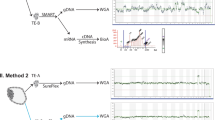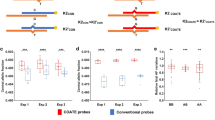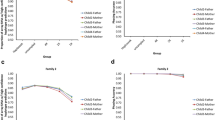Abstract
Purpose
To validate a novel and more practical system for trophectoderm DNA fingerprinting which reliably distinguishes sibling embryos from each other.
Methods
In this prospective and blinded study two-cell and 5-cell samples from commercially available sibling cell lines and excess DNA from trophectoderm biopsies of sibling human blastocysts were evaluated for accurate assignment of relationship using qPCR-based allelic discrimination from 40 single nucleotide polymorphisms (SNPs) with low allele frequency variation and high heterozygosity.
Results
Cell samples with self relationships averaged 95.1 ± 5.9 % similarity. Sibling relationships averaged 57.2 ± 5.9 % similarity for all 40 SNPs, and 40.8 ± 8.2 % similarity for the 25 informative SNPs. Assignment of relationships was accomplished with 100 % accuracy for cell lines and embryos.
Conclusions
These data demonstrate the first trophectoderm qPCR-based DNA fingerprinting technology capable of unequivocal discrimination of sibling human embryos. This methodology will empower research and development of new markers of, and interventions that influence embryonic reproductive potential.


Similar content being viewed by others
References
Jones Jr HW. Seven roads traveled well and seven to be traveled more. Fertil Steril. 2011;95:853–6.
Scott Jr RT. Using the “omics” to assess the reproductive competence of individual embryos. Chicago: Midwest Reproductive Symposium; 2011.
Treff NR, Ferry KM, Zhao T, Su J, Forman EJ, Scott RT. Cleavage stage embryo biopsy significantly impairs embryonic reproductive potential while blastocyst biopsy does not: a novel paired analysis of cotransferred biopsied and non-biopsied sibling embryos. Fertil Steril. 2011;96:S2.
Forman EJ, Ferry KM, Benson MR, Campos J, Treff NR, Scott RT. Embryos derived from vitrified oocytes are not at an increased risk of aneuploidy and demonstrate excellent implantation rates: a paired, randomized controlled trial (RCT) in an infertile population. Fertil Steril. 2011;96:S44.
Treff NR, Su J, Lonczak A, Taylor D, Scott Jr RT. A subset of the cumulus cell transcriptome is predictive of euploid human oocyte reproductive potential. Fertil Steril. 2010;94:S34–S5.
Treff NR, Su J, Taylor D, Scott Jr RT. Telomere DNA deficiency is associated with development of human embryonic aneuploidy. PLoS Genet. 2011;7:e1002161.
Su J, Tao X, Baglione G, Treff NR, Scott RT. Mitochondrial DNA is significantly increased in aneuploid human embryos. Fertil Steril. 2010;94:S88–S9.
Treff NR, Su J, Kasabwala N, Tao X, Miller KA, Scott Jr RT. Robust embryo identification using first polar body single nucleotide polymorphism microarray-based DNA fingerprinting. Fertil Steril. 2010;93:2453–5.
Treff NR, Su J, Tao X, Miller KA, Levy B, Scott Jr RT. A novel single-cell DNA fingerprinting method successfully distinguishes sibling human embryos. Fertil Steril. 2009;94:477–84.
Treff NR, Tao X, Su J, Lonczak A, Northrop LE, Ruiz A, et al. Tracking embryo implantation using cell-free fetal DNA enriched from maternal circulation at 9 weeks gestation. Mol Hum Reprod. 2011;17:434–8.
Pakstis AJ, Speed WC, Kidd JR, Kidd KK. Candidate SNPs for a universal individual identification panel. Hum Genet. 2007;121:305–17.
Cui XF, Li HH, Goradia TM, Lange K, Kasasian Jr HH, Galas D, et al. Single-sperm typing: determination of genetic distance between the G gamma-globin and parathyroid hormone loci by using the polymerase chain reaction and allele-specific oligomers. Proc Natl Acad Sci U S A. 1989;86:9389–93.
Treff NR, Tao X, Ferry KM, Su J, Taylor D, Scott RT, Jr. Development and validation of an accurate quantitative real-time PCR based assay for human blastocyst comprehensive chromosomal aneuploidy screening fertility and sterility 2012;In Press.
Author information
Authors and Affiliations
Corresponding author
Additional information
Capsule A method of quantitative real-time PCR that distinguishes sibling cell lines and embryos was developed. This inexpensive and powerful technology represents a new more practical solution to support the validation of markers and the evaluation of interventions that may influence embryonic reproductive competence.
Electronic supplementary material
Below is the link to the electronic supplementary material.
Table S1
(DOC 53 kb)
Rights and permissions
About this article
Cite this article
Scott, R.T., Su, J., Tao, X. et al. Trophectoderm DNA fingerprinting by quantitative real-time PCR successfully distinguishes sibling human embryos. J Assist Reprod Genet 31, 1421–1425 (2014). https://doi.org/10.1007/s10815-014-0315-z
Received:
Accepted:
Published:
Issue Date:
DOI: https://doi.org/10.1007/s10815-014-0315-z




